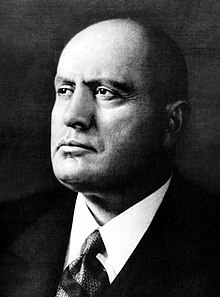
Back Benito Mussolini Afrikaans Benito Mussolini ALS ሙሶሊኒ Amharic Benito Mussolini AN Benito Mussolini ANG बेनितो मुसोलिनी ANP بينيتو موسوليني Arabic بينيطو موسوليني ARY بينيتو موسولينى ARZ Benito Mussolini AST
Benito Mussolini | |||||||||||||||||||||||||||||||||||||||||||||||||||||||||||||||||||||||||||||||||||||||||||||||||||||||||||||||
|---|---|---|---|---|---|---|---|---|---|---|---|---|---|---|---|---|---|---|---|---|---|---|---|---|---|---|---|---|---|---|---|---|---|---|---|---|---|---|---|---|---|---|---|---|---|---|---|---|---|---|---|---|---|---|---|---|---|---|---|---|---|---|---|---|---|---|---|---|---|---|---|---|---|---|---|---|---|---|---|---|---|---|---|---|---|---|---|---|---|---|---|---|---|---|---|---|---|---|---|---|---|---|---|---|---|---|---|---|---|---|---|
 Mussolini in 1939 | |||||||||||||||||||||||||||||||||||||||||||||||||||||||||||||||||||||||||||||||||||||||||||||||||||||||||||||||
| Prime Minister of Italy[a] | |||||||||||||||||||||||||||||||||||||||||||||||||||||||||||||||||||||||||||||||||||||||||||||||||||||||||||||||
| In office 31 October 1922 – 25 July 1943 | |||||||||||||||||||||||||||||||||||||||||||||||||||||||||||||||||||||||||||||||||||||||||||||||||||||||||||||||
| Monarch | Victor Emmanuel III | ||||||||||||||||||||||||||||||||||||||||||||||||||||||||||||||||||||||||||||||||||||||||||||||||||||||||||||||
| Preceded by | Luigi Facta | ||||||||||||||||||||||||||||||||||||||||||||||||||||||||||||||||||||||||||||||||||||||||||||||||||||||||||||||
| Succeeded by | Pietro Badoglio | ||||||||||||||||||||||||||||||||||||||||||||||||||||||||||||||||||||||||||||||||||||||||||||||||||||||||||||||
| Duce of the Italian Social Republic | |||||||||||||||||||||||||||||||||||||||||||||||||||||||||||||||||||||||||||||||||||||||||||||||||||||||||||||||
| In office 23 September 1943 – 25 April 1945 | |||||||||||||||||||||||||||||||||||||||||||||||||||||||||||||||||||||||||||||||||||||||||||||||||||||||||||||||
| Preceded by | Office established | ||||||||||||||||||||||||||||||||||||||||||||||||||||||||||||||||||||||||||||||||||||||||||||||||||||||||||||||
| Succeeded by | Office abolished | ||||||||||||||||||||||||||||||||||||||||||||||||||||||||||||||||||||||||||||||||||||||||||||||||||||||||||||||
| Duce of Fascism | |||||||||||||||||||||||||||||||||||||||||||||||||||||||||||||||||||||||||||||||||||||||||||||||||||||||||||||||
| In office 23 March 1919 – 28 April 1945 | |||||||||||||||||||||||||||||||||||||||||||||||||||||||||||||||||||||||||||||||||||||||||||||||||||||||||||||||
| Preceded by | Movement established | ||||||||||||||||||||||||||||||||||||||||||||||||||||||||||||||||||||||||||||||||||||||||||||||||||||||||||||||
| Succeeded by | Movement abolished | ||||||||||||||||||||||||||||||||||||||||||||||||||||||||||||||||||||||||||||||||||||||||||||||||||||||||||||||
| |||||||||||||||||||||||||||||||||||||||||||||||||||||||||||||||||||||||||||||||||||||||||||||||||||||||||||||||
| Personal details | |||||||||||||||||||||||||||||||||||||||||||||||||||||||||||||||||||||||||||||||||||||||||||||||||||||||||||||||
| Born | 29 July 1883 Dovia di Predappio, Forlì, Kingdom of Italy | ||||||||||||||||||||||||||||||||||||||||||||||||||||||||||||||||||||||||||||||||||||||||||||||||||||||||||||||
| Died | 28 April 1945 (aged 61) Giulino di Mezzegra, Como, Italian Social Republic | ||||||||||||||||||||||||||||||||||||||||||||||||||||||||||||||||||||||||||||||||||||||||||||||||||||||||||||||
| Cause of death | Summary execution | ||||||||||||||||||||||||||||||||||||||||||||||||||||||||||||||||||||||||||||||||||||||||||||||||||||||||||||||
| Resting place | San Cassiano cemetery, Predappio, Italy | ||||||||||||||||||||||||||||||||||||||||||||||||||||||||||||||||||||||||||||||||||||||||||||||||||||||||||||||
| Political party | PNF (1921–1943) | ||||||||||||||||||||||||||||||||||||||||||||||||||||||||||||||||||||||||||||||||||||||||||||||||||||||||||||||
| Other political affiliations |
| ||||||||||||||||||||||||||||||||||||||||||||||||||||||||||||||||||||||||||||||||||||||||||||||||||||||||||||||
| Spouses | |||||||||||||||||||||||||||||||||||||||||||||||||||||||||||||||||||||||||||||||||||||||||||||||||||||||||||||||
| Domestic partners |
| ||||||||||||||||||||||||||||||||||||||||||||||||||||||||||||||||||||||||||||||||||||||||||||||||||||||||||||||
| Relatives | Mussolini family | ||||||||||||||||||||||||||||||||||||||||||||||||||||||||||||||||||||||||||||||||||||||||||||||||||||||||||||||
| Signature |  | ||||||||||||||||||||||||||||||||||||||||||||||||||||||||||||||||||||||||||||||||||||||||||||||||||||||||||||||
| Military service | |||||||||||||||||||||||||||||||||||||||||||||||||||||||||||||||||||||||||||||||||||||||||||||||||||||||||||||||
| Allegiance | Kingdom of Italy | ||||||||||||||||||||||||||||||||||||||||||||||||||||||||||||||||||||||||||||||||||||||||||||||||||||||||||||||
| Branch/service | Royal Italian Army | ||||||||||||||||||||||||||||||||||||||||||||||||||||||||||||||||||||||||||||||||||||||||||||||||||||||||||||||
| Years of service | 1915–1917 (active) | ||||||||||||||||||||||||||||||||||||||||||||||||||||||||||||||||||||||||||||||||||||||||||||||||||||||||||||||
| Rank | |||||||||||||||||||||||||||||||||||||||||||||||||||||||||||||||||||||||||||||||||||||||||||||||||||||||||||||||
| Unit | 11th Bersaglieri Regiment | ||||||||||||||||||||||||||||||||||||||||||||||||||||||||||||||||||||||||||||||||||||||||||||||||||||||||||||||
| Battles/wars | |||||||||||||||||||||||||||||||||||||||||||||||||||||||||||||||||||||||||||||||||||||||||||||||||||||||||||||||
| a. ^ As Head of Government, Prime Minister, Secretary of State from 24 December 1925 | |||||||||||||||||||||||||||||||||||||||||||||||||||||||||||||||||||||||||||||||||||||||||||||||||||||||||||||||
Benito Amilcare Andrea Mussolini[a] (29 July 1883 – 28 April 1945) was an Italian politician who was the dictator of Fascist Italy from the March on Rome in 1922, until his overthrow in 1943. He was also Duce of Italian fascism from the establishment of the Italian Fasces of Combat in 1919, until his summary execution in 1945. He founded and led the National Fascist Party (PNF). As a dictator and founder of fascism, Mussolini inspired the international spread of fascist movements during the interwar period.[1]
Mussolini was originally a socialist politician and journalist at the Avanti! newspaper. In 1912, he became a member of the National Directorate of the Italian Socialist Party (PSI), but was expelled for advocating military intervention in World War I. In 1914, Mussolini founded a newspaper, Il Popolo d'Italia, and served in the Royal Italian Army until he was wounded and discharged in 1917. He eventually denounced the PSI, his views now centering on Italian nationalism, and founded the fascist movement which opposed egalitarianism and class conflict, instead advocating "revolutionary nationalism" transcending class lines. In October 1922, following the March on Rome, he was appointed prime minister by King Victor Emmanuel III. After removing opposition through his secret police and outlawing labour strikes, Mussolini and his followers consolidated power through laws that transformed the nation into a one-party dictatorship. Within five years, he established dictatorial authority by legal and illegal means and aspired to create a totalitarian state. In 1929, he signed the Lateran Treaty to establish Vatican City.
Mussolini's foreign policy was based on the fascist doctrine of "Spazio vitale" ("living space"), which aimed to expand Italian possessions. In the 1920s, he ordered the Pacification of Libya, the bombing of Corfu over an incident with Greece, and annexed Fiume, after a treaty with Yugoslavia. In 1936, Ethiopia was conquered following the Second Italo-Ethiopian War and merged into Italian East Africa (AOI) with Eritrea and Somalia. In 1939, Italian forces annexed Albania. Between 1936 and 1939, Mussolini ordered an intervention in Spain in favour of Francisco Franco, during the Spanish Civil War. Mussolini took part in the Treaty of Lausanne, Four-Power Pact and Stresa Front. However, he alienated the democratic powers as tensions grew in the League of Nations, which he left in 1937. Now hostile to France and Britain, Italy formed the Axis alliance with Nazi Germany and Imperial Japan.
The wars of the 1930s cost Italy enormous resources, leaving it unprepared for the Second World War; Mussolini initially declared Italy's non-belligerence. However, in June 1940, believing Allied defeat imminent, he joined the war on Germany's side, to share the spoils. After the tide turned, and the Allied invasion of Sicily, King Victor Emmanuel III dismissed Mussolini as head of government and placed him in custody in July 1943. After the king agreed to an armistice with the Allies, in September 1943, Mussolini was rescued in the Gran Sasso raid by Germany. Hitler made Mussolini the figurehead of a puppet state in German-occupied north Italy, the Italian Social Republic, which served as a collaborationist regime of the Germans. With Allied victory imminent, Mussolini and mistress Clara Petacci attempted to flee to Switzerland, but were captured by communist partisans and executed on 28 April 1945.
Cite error: There are <ref group=lower-alpha> tags or {{efn}} templates on this page, but the references will not show without a {{reflist|group=lower-alpha}} template or {{notelist}} template (see the help page).
- ^ "BBC - History - Historic Figures: Benito Mussolini (1883-1945)". www.bbc.co.uk. Retrieved 1 September 2024.
